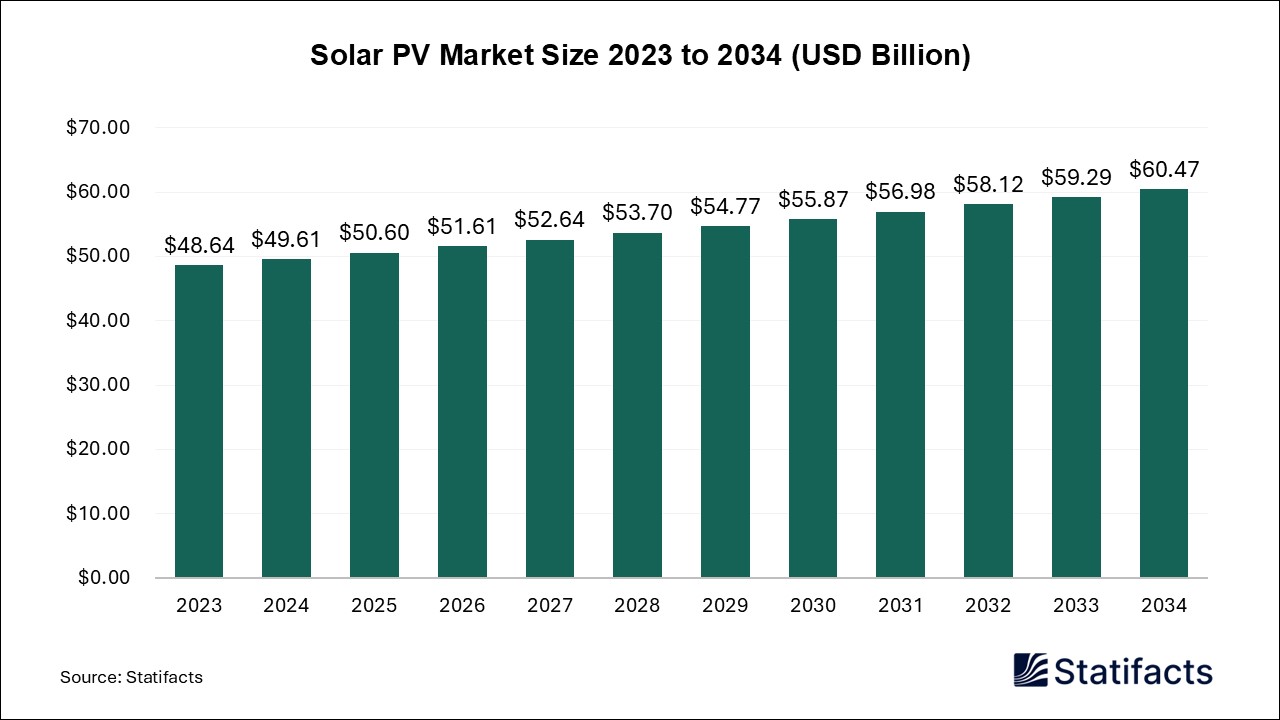Last Updated: 23 Jul 2025
Source: Statifacts
By clicking “Accept All Cookies” you agree to the storing of cookies on your device to enhance site navigation, analyze site usage, and assist in our marketing efforts.
Privacy PolicyUS Ferrous Metal Market (By Material: Gray Iron, Ductile Iron, Carbon Steel, Stainless Steel, Others) Industry Size, Share, Growth, Trends 2025 to 2034.
The global US ferrous metal market size accounted for USD 32.37 billion in 2024 and is predicted to touch around USD 45.98 billion by 2034, growing at a CAGR of 3.57% from 2025 to 2034.
| Industry Worth | Details |
| Market Size in 2025 | USD 33.70 Billion |
| Market Size by 2034 | USD 45.98 Billion |
| Market Growth Rate from 2025 to 2034 | CAGR of 3.57% |
Ferrous metals include iron and a few of its alloys, such as steel and cast iron. Ferrous metals are the material of choice for many construction projects like bridges, highways, commercial buildings, etc., transportation projects like vehicles and heavy machinery, and energy projects like oil rigs, pipelines, and wind turbines. The U.S., ferrous metals market widely provides for the commercial building industry, automotive manufacturers, and energy industries such as equipment on oil rigs, pipelines, and wind turbines. With the U.S. continuing to invest in sustainable infrastructure and transitioning toward electric vehicles, it is expected that there will be long-term demand for ferrous metals across multiple verticals.
Artificial Intelligence (AI) has enhanced efficiency and productivity in the U.S. ferrous metal market. AI systems are currently being utilized to not only identify and sort scrap metals but also process scrap metals in a more effective manner. The implementations of AI have enhanced multi-faceted recycling recovery rates in collection and processing, and efficiency in product consumption in many recycling plants, while also reducing contamination and incorrect sorting. Predictive maintenance supported by AI in the form of predictive analytics will reduce downtime in steel mills by predicting where equipment failure will occur.
Demand forecasting supported by AI will improve decision making related to inventory and supply chain steps, predicated on existing storage and demand forecasting ability, which will ultimately help in reducing waste and cost. There are suppliers like Nucor who are currently using AI-based technologies to optimize furnace temperatures and find efficiencies to reduce energy consumption. All these efforts and advancements will have increased the speed of production, reduced negative outcomes of production to the environment, and lower costs while enhancing the ability of domestic ferrous producers to achieve sustainability goals.
The market trends in the U.S. ferrous metal market are characterized by a boom in commercial and residential construction activities, a surge in the awareness of domestic steel production and recycling, geographic price variations, and bearish market sentiments towards domestic production.
The U.S. ferrous metal market experiences growth restraints due to factors such as skilled labor shortage in the U.S. industries, global trade fluctuations, and volatile supply of raw materials.
Global trade fluctuations and volatile supply of raw materials: Despite its increasing domestic output, the U.S. ferrous metal market is dependent on iron ore and metallurgical coal imported from outside the country. Even with the U.S. increasing domestic production, disruptions in the global supply chain, such as through geopolitical unrest or port strikes, can have three potential adverse impacts on the availability of raw materials. For instance, shipping delays caused by the 2023 disruption of Barcelona's port in the Red Sea affected several bulk shipments' delivery of materials that prevented U.S. mills from operating. Furthermore, the uncertainty of international trade policy and tariffs introduces an element of unpredictability for steelmakers who rely on complex cross-border supply chains. Each of these impacts leads to instability in prices that reduces efficiency for U.S. ferrous metal producers or increases production costs overall.
Skilled labor shortage in the U.S. industries: The U.S. ferrous metal market is considerably short of skilled labor. The market is projected to have a labor shortage of skilled workers needed for it to run smoothly. There are full-time, older workers with freezer-burned welders, but older metalworkers will retire without adequate replacements. More than 30 percent of the current workforce employed in metalworking is expected to retire by the year 2030, according to the U.S. Bureau of Labor Statistics. Thus, the labor gap creates reduced productivity and delayed projects, which contribute to reduced output. Training and retention programs are limited, and employment is mainly physically demanding, which presents challenges for recruitment.
The opportunities in the U.S. ferrous metal market are associated with the adoption of carbon-neutral technologies, the expansion of the energy sector in defense and renewable and growth in the scrap recycling sectors.
“Drawing from the combined strengths of both organizations, this is an opportunity to accelerate Radius’ strategic priorities, access new growth opportunities, and further solidify our position as a leader in North American recycling, opens new doors for Radius.”
“We are excited to have reached this agreement with TTC Like Radius. TTC is a proven leader in metals and automotive recycling services and solutions, and we look forward to enhancing and expanding our offerings as part of their larger organization while continuing to drive our strategy forward.”
“We look forward to collaborating with Radius, whose position as one of North America’s leading recycling companies aligns with our efforts to holistically improve recycling across the supply chain.”
Gray iron was the dominant metal in the U.S. ferrous metal market because it typically sees the most significant use in construction, automotive, and municipal applications (manhole covers, pipes, engine blocks), both as a base material and in cast components. Its great machinability, dampening of vibrations, and low cost of production make gray iron a great choice for high volume manufacturing. Heavy-duty industrial equipment (e.g., gears, frames, table saws, etc.) for U.S. foundries relies significantly and consistently on gray iron over other ferrous metals. Infrastructure projects have consistent demand for gray iron, regardless of the project or sector.
The fastest-growing segment in the U.S. ferrous metal market is stainless steel. The sale of stainless steel in the U.S. is increasing rapidly due to the rise in demand in food processing, medical equipment, and from electric vehicle production industry. The corrosion-resistant properties, durability, and recyclability properties of stainless steel make it one of the best choices for clean energy systems, medical and surgical tools, sustainable infrastructure, and materials. The transition toward decarbonization across sectors, as well as demand for ESG-compliant materials, all fuel the demand for stainless steel across the U.S. market.
The U.S. ferrous metal market is competitive, with major global and domestic players competing to gain the largest market share. Some of the key players in the market include Nucor Corporation, Commercial Metals Co., SA Recycling LLC, POSCO, Tata Steel, ArcelorMittal, and Gerdau.
Some of the companies that stand out from the prominent ones in terms of their market holding in the U.S. are the following:
Nucor is a prominent U.S. steel manufacturer providing bars, beams, sheets, and plates. Nucor operates electric arc furnaces and has invested a significant amount of funding into the future of sustainable steelmaking, as well as battery and green hydrogen technologies.
CMC manufactures long steel products, including rebar (reconstruction steel) and wire rod, throughout the U.S. and Europe. Along with the long steel manufacturing, CMC also participates in recycling operations, which largely provide construction-grade steel, as well as some mini mill technologies that achieve an improved energy efficiency performance.
SA Recycling operates over 125 locations throughout the U.S., processing ferrous and non-ferrous scrap for recycling. SA hosts recycling scrap consumers of recycled metals brought into steel mills, while it continues to invest in electric shredders and recovery technologies.
| Segments | Shares (%) |
| Carbon Steel | 48% |
| Ductile Iron | 22% |
| Gray Iron | 15% |
| Stainless Steel | 9% |
| Others | 6% |
Published by Saurabh Bidwai
| Material | 2024 | 2025 | 2026 | 2027 | 2028 | 2029 | 2030 | 2031 | 2032 | 2033 | 2034 |
|---|---|---|---|---|---|---|---|---|---|---|---|
| Carbon Steel | 15.54 | 16 | 16.48 | 16.96 | 17.46 | 17.99 | 18.55 | 19.09 | 19.62 | 20.26 | 20.85 |
| Ductile Iron | 7.12 | 7.34 | 7.58 | 7.81 | 8.06 | 8.32 | 8.58 | 8.85 | 9.14 | 9.42 | 9.73 |
| Gray Iron | 4.86 | 4.96 | 5.07 | 5.19 | 5.30 | 5.41 | 5.53 | 5.65 | 5.77 | 5.90 | 6.02 |
| Stainless Steel | 2.91 | 3.12 | 3.34 | 3.56 | 3.81 | 4.06 | 4.33 | 4.61 | 4.91 | 5.23 | 5.56 |
| Others | 1.94 | 2.11 | 2.29 | 2.49 | 2.69 | 2.90 | 3.13 | 3.37 | 3.62 | 3.88 | 4.17 |
Last Updated: 23 Jul 2025
Source: Statifacts
| Subsegment | 2024 | 2025 | 2026 | 2027 | 2028 | 2029 | 2030 | 2031 | 2032 | 2033 | 2034 |
|---|---|---|---|---|---|---|---|---|---|---|---|
| Carbon Steel | 15.54 | 16 | 16.48 | 16.96 | 17.46 | 17.99 | 18.55 | 19.09 | 19.62 | 20.26 | 20.85 |
| Ductile Iron | 7.12 | 7.34 | 7.58 | 7.81 | 8.06 | 8.32 | 8.58 | 8.85 | 9.14 | 9.42 | 9.73 |
| Gray Iron | 4.86 | 4.96 | 5.07 | 5.19 | 5.30 | 5.41 | 5.53 | 5.65 | 5.77 | 5.90 | 6.02 |
| Stainless Steel | 2.91 | 3.12 | 3.34 | 3.56 | 3.81 | 4.06 | 4.33 | 4.61 | 4.91 | 5.23 | 5.56 |
| Others | 1.94 | 2.11 | 2.29 | 2.49 | 2.69 | 2.90 | 3.13 | 3.37 | 3.62 | 3.88 | 4.17 |
Growth is largely driven by robust infrastructure development, rising demand from sectors like automotive and energy, and increased adoption of sustainable steel-making processes like Electric Arc Furnace (EAF) technology.
Electric arc furnaces, primarily processing recycled scrap, now lead U.S. steel production, reflecting a shift toward circular, low-carbon manufacturing. Traditional integrated mills remain relevant but are being complemented by efficient scrap-based mini-mills.
The industry faces volatility from tariffs and global competition, tight raw material pricing, and trade-related uncertainties. Excess capacity and supply chain bottlenecks also pressure profitability and investment decisions.
Ferrous scrap recycling remains vital to steel production and sustainability efforts, but prices are under pressure due to reduced industrial demand, especially from automotive and construction sectors, and tariff-driven market distortions.
Significant opportunities exist in renewable energy infrastructure, data center construction, and AI-driven predictive maintenance for steel plants. Consolidation through vertical integration and M&A is also enabling strategic expansion for major producers.
To get full access to our Market Insights, you need a Professional Account or a Business Suite.

You will receive an email from our Business Development Manager. Please be sure to check your SPAM/JUNK folder too.

You will receive an email from our Business Development Manager. Please be sure to check your SPAM/JUNK folder too.

Our customers work more efficiently and benefit from


